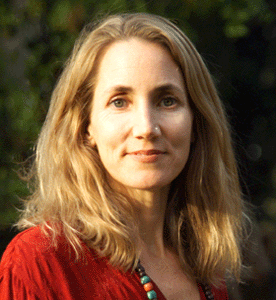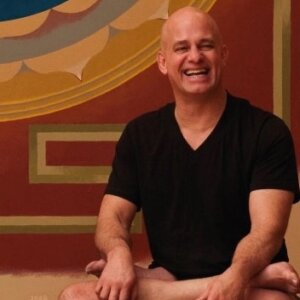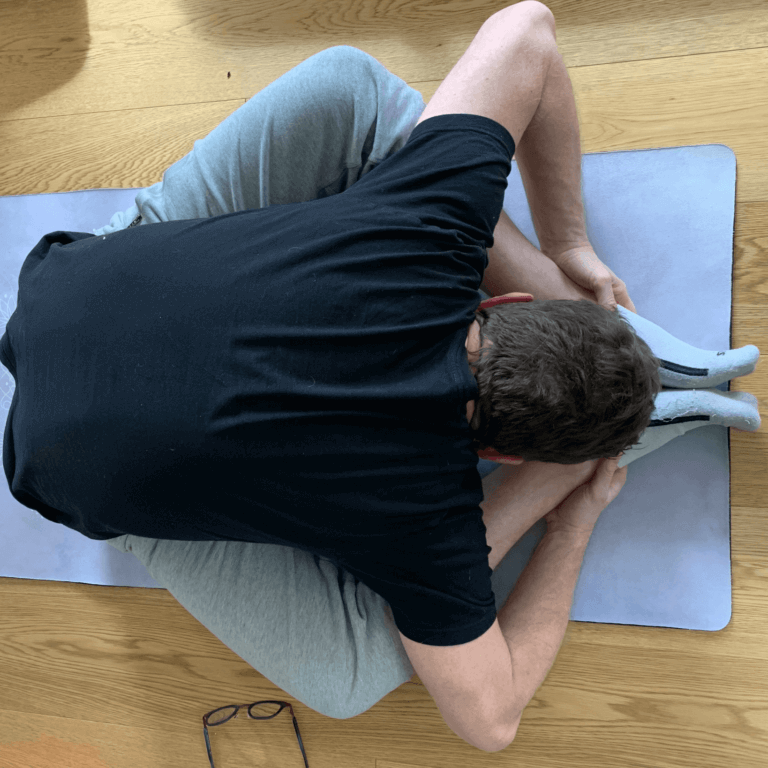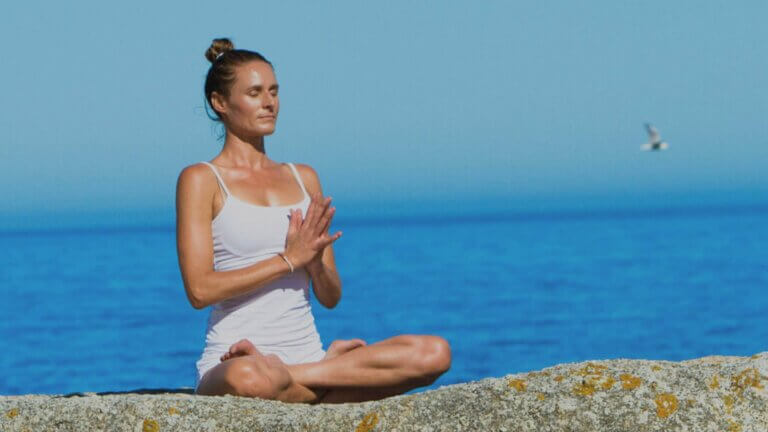Home » Yoga Blog » Beginner Yoga Blog » Yin Yoga Explained: A Guide to the History, Practice and Benefits
Yin Yoga Explained: A Guide to the History, Practice and Benefits
Introduction
Yin Yoga is a distinct and meditative branch within the diverse yoga world. Unlike its more active counterparts, this form emphasizes long-held, passive poses, providing a unique approach to wellness and mindfulness. The essence of this practice lies in its slow pace and focus on the body’s deeper tissues. This contrast with dynamic forms like Vinyasa or Ashtanga makes this practice a perfect complement, rather than a replacement, offering a holistic approach to physical and mental health. To know Yin Yoga, one must explore its history, characteristics, philosophy, benefits and poses.
At its core, this practice targets the connective tissues, such as ligaments and fascia, encouraging a deep release and increased flexibility. The long duration of poses, typically three to ten minutes, helps practitioners delve into a deeper state of relaxation and introspection.
This style is about physical stretch and exploring yoga’s subtler, meditative aspects.
Origin & History of Yin Yoga


The journey and history of Yin Yoga began in the late 1980s, deeply rooted in the philosophies and practices of both yoga and martial arts. Paul Grilley, a yoga teacher and anatomy student, played a pivotal role in Yin Yoga history and development. Grilley’s encounter with Paulie Zink, a martial arts champion and Taoist Yoga master, sparked his interest in the long-held poses that would become the foundation of this beloved practice.
Intrigued by Zink’s extraordinary flexibility and the Taoist approach to yoga, Grilley began experimenting with these prolonged poses. Although initially focusing on dynamic styles like Vinyasa Yoga, Grilley discovered that incorporating passive stretching into his routine significantly improved his students’ flexibility and range of motion. This finding inspired the creation of a yoga practice that focused on the deeper, yin aspects of the body – the connective tissues and joints.
One of Grilley’s students, Sarah Powers, suggested calling the practice “Yin Yoga.” It aptly reflected the practice’s focus on the passive, yielding qualities of yin, in contrast to the more active, dynamic yang. This new style of yoga quickly garnered attention for its unique approach and profound benefits, establishing itself as an integral part of modern yoga practices. And with that Sarah Powers too became an important figure in Yin Yoga History.
Critical Characteristics
The practice of Yin Yoga is distinct by several key characteristics that set it apart from more dynamic yoga styles:
- Long-Held Poses: One of the most distinctive features of Yin Yoga is its long-held poses, typically ranging from 5 to 10 minutes. This extended duration is crucial for accessing the body’s more profound layers of connective tissues.
- Focus on Connective Tissues: This yoga style targets the connective tissues, such as fascia, ligaments, and joints. This focus helps release tension and increase flexibility in these often neglected areas.
- Breathing Patterns: In this practice, breathing is slow and mindful, emphasizing relaxed belly breathing. This type of breathing enhances relaxation and aids in maintaining poses for more extended periods.
- Distinction from Dynamic Yoga Styles: Unlike dynamic yoga styles emphasizing muscular activity and movement, Yin Yoga’s character is stillness and passivity. This distinction makes it a perfect complement to more active forms of yoga, offering a balanced approach to physical and mental well-being.
The Philosophy: Understanding Yin and Yang in Yoga

Yin and Yang are fundamental concepts in both Traditional Chinese Medicine and Hatha Yoga, representing the duality and balance in nature. These concepts are foundational and a key principal through out Yin Yoga History.
- Yin and Yang in Philosophy: The principles of Yin (passive, cold, feminine) and Yang (active, hot, masculine) are integral to understanding the balance of energies in the body and the universe. Yin represents stillness and passivity, while Yang signifies activity and dynamism.
- Qualities of Yin and Yang: Yin Qualities are slow, soft, passive, and associated with elements like water and earth. Yang Qualities are fast, hard, active, and related to elements like fire and air.
- Application in Yoga Poses: In Yin Yoga, the design of the poses is to activate and harmonize these Yin and Yang energies. While some poses target the passive Yin tissues, others stimulate the more active Yang tissues, creating a balanced and holistic yoga practice.
By understanding and applying these principles in Yin Yoga poses, practitioners can achieve a more profound sense of balance and physical and mental harmony.
Functional Principles of Yin Yoga
Yin Yoga has several functional principles that ensure the practice is practical and safe.
- Application of Stress: Key elements like tension, contraction, and compression are critical in this practice. These stresses are applied gently and thoughtfully to the body’s connective tissues, enhancing flexibility and stimulating energy flow.
- Tension refers to the stretching of muscles and tissues.
- Contraction involves the tightening of muscles.
- Compression deals with the squeezing and releasing areas to increase blood flow and flexibility.
Mindful Movements and Individual Anatomical Differences
Understanding and respecting individual anatomical differences is crucial in Yin Yoga. Each practitioner’s body is unique, and poses are adjusted to suit these differences.
- Mindful movements are emphasized, with the recognition that there is no ‘one size fits all’ approach to any pose.
- Practitioners are encouraged to find positions that work best for them, acknowledging that what feels comfortable for one person might be challenging for another.
Importance of Stillness and Gradual Exit from Poses
One of the hallmarks and Benefits of Yin Yoga is the cultivation of stillness, both physically and mentally.
- Once a practitioner reaches a comfortable level of intensity in a pose, practitioners are encouraged to maintain stillness, resisting the urge to fidget or exit the pose prematurely.
- This stillness allows for a deeper stretch and a more meditative state.
- Equally important is the gradual exit from poses. After holding a pose for an extended period, moving slowly and deliberately to avoid injury and allow the body to adapt and recalibrate is crucial.
These principles make this practice a profoundly nurturing and therapeutic practice, focusing on yoga’s subtle yet powerful aspects. Practitioners learn to tune into their bodies, respect their limitations, and gently push their boundaries for holistic well-being.
You Love Yoga, We Love Yoga—Let’s Stay Connected
Get yoga tips, a little inspiration, and friendly emails—because yoga is better with friends.
Benefits, Practices, and Yin Yang
Physical Benefits
Physical Benefits
- Fascia Rejuvenation: Regular practice of Yin Yoga helps stretch and stimulate the body’s fascia, a connective tissue, thus improving flexibility and overall body function.
- Joint Health: Yin poses apply gentle stress to the joints, enhancing their range of motion and countering the effects of a sedentary lifestyle.
- Improves Flexibility: By gently stretching tendons and connective tissues, this practice helps increase muscle adaptability and reduce injury risk.
Mental, Emotional and Specific Benefits
Mental and Emotional Benefits
- Stress Reduction: The deep, prolonged stretches in Yin Yoga release stress stored in body tissues, promoting emotional releases and aiding in stress management.
- Mental Clarity: The meditative aspect of this practice, with its emphasis on stillness, helps achieve mental clarity and release deep-rooted tensions.
- Hormonal Balance: The extended poses in Yin sequences stimulate the endocrine glands, aiding in hormonal regulation and emotional stability.
- Yin Yoga relieves conditions like migraines, partly due to its calming effect on the mind and activating the parasympathetic nervous system.
Yin Yoga Poses: The 5 Archetypes

Yin Yoga comprises various poses, each targeting specific areas and offering unique benefits.
- Target Areas: Glutes, Adductors, Thoracolumbar fascia.
- Benefits: Stretches the deep lateral rotators and stimulates the knee joints.
- Practice Tips and Modifications: Modifications for stiff hips or sensitive knees include sitting on a folded blanket or using a bolster for support.
- Target Areas: Quads, Hip flexors, and Thoracolumbar fascia.
- Benefits: Provides a deep opening in the sacral lumbar arch and stimulates the thyroid gland.
- Practice Tips and Modifications: Modifications for tight quads or knee issues, such as sitting on a bolster for support, can be helpful.
- Target Areas: Hamstrings, Glutes, Thoracolumbar fascia.
- Benefits: Aids in digestion and improves the functioning of kidneys and adrenals.
- Practice Tips and Modifications: People with tight hamstrings can modify this pose by bending the knees and using a bolster.
Dragonfly Pose – Straddle (YouTube)
- Target Areas: Groin, Hamstrings.
- Benefits: Opens the hips and stretches the hamstrings and adductor muscles.
- Practice Tips and Modifications: Modifications for tight hamstrings include using bolsters or cushions for support.
- Target Areas: Glutes, Groin, Hip flexors.
- Benefits: Compresses the lateral lower back and stretches the upper thighs.
- Practice Tips and Modifications: For lower back pain, gentle entry into the pose and lesser bending of the knee are recommended.
These poses can be adapted to meet individual needs and physical limitations, making Yin Yoga a versatile and inclusive practice.
Yin Yoga How to and Tips: Playlist on YouTube
What is Yin Yang Yoga?
Yin Yang Yoga represents a harmonious blend of two fundamental elements in yoga practice: Yin (passive, meditative) and Yang (active, dynamic). This style of yoga offers a comprehensive approach by combining the deep, sustained stretches of Yin Yoga with the more rhythmic, flowing sequences typical of Yang Yoga styles. Here’s an overview.
Yin Elements in Yin Yang Yoga
- The Yin component of Yin Yang Yoga focuses on longer-held, passive poses. These poses are usually seated or reclined and held for several minutes.
- This practice targets the deep connective tissues like ligaments and fascia, encouraging a release of tension and promoting increased flexibility and joint mobility.
- It’s characterized by its meditative aspect, fostering mindfulness and deep relaxation.
Yang Elements in Yin Yang Yoga
- The Yang aspect brings in more dynamic and active sequences, often similar to Vinyasa, Ashtanga Yoga styles, or Rocket Yoga.
- This part of the practice focuses on strengthening and toning muscles, improving cardiovascular health, and promoting stamina.
- Yang sequences are rhythmic and fluid, enhancing bodily awareness, coordination, and balance.
Combining Yin and Yang
- Yin Yang Yoga sessions typically start with Yin poses to calm the mind and prepare the body, gradually transitioning into more energetic Yang sequences.
- This combination allows for a balanced practice that nurtures the body and mind, catering to holistic well-being.
- It embodies the principle of balance – emphasizing the importance of incorporating passive and active elements in yoga.
Yin Yang Yoga is suitable for a wide range of practitioners, offering the benefits of both Yin and Yang practices in a cohesive session. It’s an ideal choice for those seeking to experience the complementary nature of different yoga styles. By promoting inner peace and physical vitality.
Sources
- Yin Yoga and Traditional Chinese Medicine – Provides an in-depth understanding of how Yin Yoga incorporates concepts from Traditional Chinese Medicine (1)
- Benefits of Yin Yoga for Physical and Mental Health – A scientific perspective on the health benefits of Yin Yoga. (2)
- Yin Yoga – Wikipedia Article (3)



